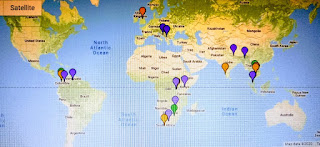International Albinism Awareness Day-2020
International Albinism Awareness Day-2020
There are quality life-promoting goals which are also motivations or catalysts contributing to our self-actualisation we aspire to. In order to achieve the goals we need to deploy agency, autonomy and self-determination to acquire self-actualisation. Some such goals are ideals like: respect, dignity, security, safety and productivity in one’s lifetime.
If you are a community with albino children or if you are a family taking care of an albino child, there are tips we researched from Mayo Clinic for you.
Lifestyle and home remedies
You can help your child learn self-care practices that should continue into adulthood:
Use low vision aids, such as a hand-held magnifying glass, a monocular or a magnifier that attaches to glasses, and a tablet synced to a smart board (an interactive electronic board with a touch screen) in the classroom.
Always use sunscreen with a sun protection factor (SPF) of 30 or greater that protects against both UVA and UVB light.
Strictly avoid high-risk or prolonged sun exposure, such as being outside for long periods of time or in the middle of the day, at high altitudes, and on sunny days with thin cloud cover.
Wear protective clothing, including clothes with color, such as long-sleeve, collared shirts, long pants and socks; broad-brimmed hats; and special UV-protection clothing.
Protect eyes wearing dark, UV-blocking sunglasses or transition lenses (photochromic lenses) that darken in bright light.
Coping and support
Making school or work adjustments
If your child has albinism, begin early to work with teachers and school administrators to take measures to help your child adapt to classroom learning. If necessary, start with educating the school professionals about albinism and how it affects your child. Also ask about services that the school or workplace offers to assess and meet needs.
Adjustments to the classroom or work environment that may help include:
A seat near the front of the classroom
Large-print textbooks or a tablet computer
A tablet computer that can be synced to an interactive whiteboard (SMART board) at the front of the room, allowing the child to sit farther back in the classroom
Handouts of the content written on boards or overhead screens
High-contrast printed documents, such as black type on white paper, rather than using colored print or paper
Enlarging font size on a computer screen
Avoiding bright light in the learning or work setting
Allowing extra time for taking tests or reading material
Coping with emotional and social issues
Help your child develop skills to deal with other people's reactions to albinism. For example:
Encourage your child to talk to you about experiences and feelings.
Practice responses to teasing or embarrassing questions.
Find a peer support group or online community through agencies such as the National Organization for Albinism and Hypopigmentation (NOAH).
Talk to a mental health professional who can help you and your child develop healthy communication and coping skills, if needed.
We are aware contexts or status like: one’s skin colour; height, body type; origins; tribe; economic status; sexuality; position; power; age; and family influence decisions to engage in practices that promote quality life.
We are giving special focus today on persons with albinism and other persons marginalised just because they do not demand recognition the way the world has been normed.
The following are typical vulnerabilities in children with albinism prior to abuse:
· Living in a chaotic or dysfunctional household (including parental substance use, domestic violence, parental mental health issues, parental criminality)
· History of abuse (including familial child sexual abuse, risk of forced marriage, risk of 'honour'-based violence, physical and emotional abuse and neglect)
· Recent bereavement or loss
· Gang association either through: cultural leaders, relatives, peers or intimate relationships
· Attending school with young people who are sexually exploited
· Learning disabilities
· Unsure about their sexual orientation or unable to disclose sexual orientation to their families
· Friends with young people who are sexually exploited
· Homelessness
· Lacking friends or peers from the same age group
· Living in a gang neighbourhood
· Living in residential care
· Living in hostel, bed and breakfast accommodation or a foyer
· Low self-esteem or self-confidence
· Young care-givers taking care of them.
Our work at grassroots has brought albinism to our attention too. In order to accommodate the needs of persons with albinism as they grow, we also have to draw attention to the influence of COVID-19, poverty, HIV/AIDS, Domestic Violence, illiteracy, and natural calamities making it too difficult for households to give persons with albinism the care and support that they deserve. Support persons with albinism to lead quality life by addressing their human needs too. Do not discriminate nor stigmatise them.




Comments
Post a Comment